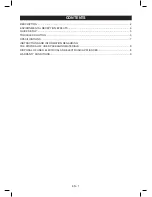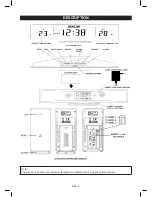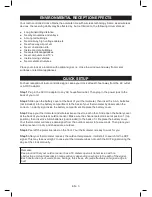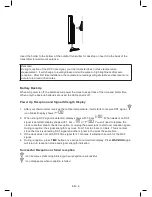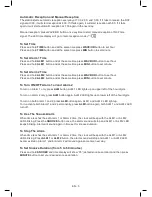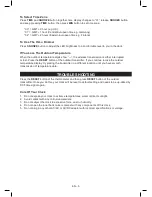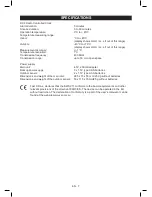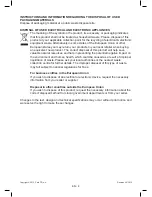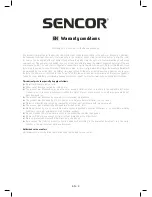
EN - 3
ENVIRONMENTAL RECEPTION EFFECTS
Your radio controlled clock obtains the accurate time with wireless technology. Same as all wireless
devices, the receiving ability maybe affected by, but not limited to, the following circumstances:
●
Long transmitting distance
●
Nearby mountains and valleys
●
Among tall buildings
●
Near railway, high voltage cable etc.
●
Near freeway, airport, etc
●
Near construction site
●
Inside concrete buildings
●
Near electrical appliances
●
Near computers and TV’s
●
Inside moving vehicles
●
Near metallic structures
Place your clock at a location with optimal signal, i.e. close to a window and away from metal
surfaces or electrical appliances.
QUICK SETUP
For best reception of radio controlled signal, keep your clock at least 3 feet away from the AC outlet
or AC/DC adaptor.
Step 1
Plug in the AC/DC adaptor to any AC household outlet. Then plug in the power jack to the
back of your unit.
Step 2
Slide open the battery cover at the back of your thermometer, then insert 3 x AAA batteries
(not included) into the battery compartment to the back of your thermometer by observation the
c/- polarity sign inside the battery compartment. Replace the battery cover.
Step 3
Keep your thermometer and wireless sensor next to each other. Slide open the battery cover
at the back of your wireless outdoor sensor. Make sure the channel selector is set at position 1 (top
position), then insert 2 x AAA batteries (not included) to the back of it. Replace the battery cover.
Your thermometer will receive data signal from the outdoor sensor in few seconds. Then place your
outdoor sensor in a dry and shaded area outdoor.
Step 4
Peel off the protective label on the front. Your thermometer is ready to work for you.
Step 5
After your thermometer receives the outdoor temperature, it will start to search for the DCF
signal. This may take overnight. In case your thermometer does not catch the DCF signal during the
day, set the clock manually.
Remarks:
Keep in mind that your outdoor sensor has a 50 meters open-air transmission with no
obstructions. Actual transmission range will vary depending on what is in the path of the signal.
Each obstruction (roof, walls,
fl
oors, ceilings, thick trees, etc.) will effectively cut signal range in
half.
Содержание SWS 211
Страница 2: ......
Страница 12: ...EN 10...



